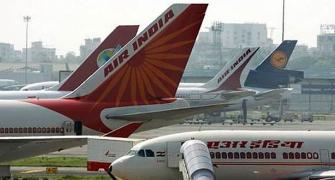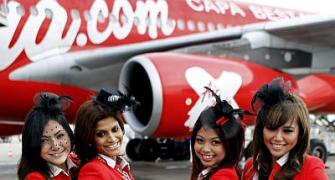 AirAsia India will get a cost advantage over other airline start-ups. For, it can rely on its parent for aircraft lease, maintenance support and training.
AirAsia India will get a cost advantage over other airline start-ups. For, it can rely on its parent for aircraft lease, maintenance support and training.
Even so, its aim of achieving break-even in six to 12 months is difficult, say experts.
Initially the airline was aiming to achieve a break-even in four months; recently, it pushed back the target.
The head of investor relations of AirAsia Malaysia, the parent company, said it was not possible for the Indian subsidiary to reach break-even before eight months.
And, the group chief executive officer, Tony Fernandes, said the break-even would be achieved in a year.
AIMING HIGH
•Initially, AirAsia aimed to achieve break-even in four months, but recently pushed back the target
•AirAsia India has a single Airbus A320 and operates six flights between Bangalore and Chennai and Bangalore and Goa
•Typically, airlines in India spend 45-50 per cent of total expense on fuel and five to 10 per cent on airport charges
AirAsia India has a single Airbus A320 and operates six flights between Bangalore and Chennai and Bangalore and Goa. It has announced a Bangalore-Kochi flight from Sunday.
AirAsia Malaysia has among the lowest unit costs (cost involved in flying a seat over a kilometre) in the world and has invested in programmes to reduce it further.
This includes a programme with GE Aviation, aimed to help in saving $20 million in five years. However, operating costs in India are high and AirAsia will not enjoy the cost advantage it gets in its Southeast Asia market.
Typically, airlines in India spend 45-50 per cent of total expense on fuel and five to 10 per cent on airport charges.
India does not have low-cost airport terminals.
Also, fuel costs in India are higher due to state and central taxes.
Fuel accounts for around 45 per cent of airline costs in India; the global average is around 33 percent, according to a KPMG report on Indian aviation.
In Malaysia, AirAsia sells about 85 per cent of tickets through its website, reducing distribution costs.
In India, 70-80 per cent of tickets are sold by agents. Also, in Malaysia it earns 18 per cent of revenue from ancillary sources.
That is another challenge here. It has already been forced to allow 15 kg check-in bags like other domestic airlines, after the Directorate General of Civil Aviation disapproved the concept of no-free luggage.
An airline spreads its overhead costs and lowers unit costs as it grows its fleet, say experts.
These costs are related to salaries, engineering, distribution and ground handling. A bigger network also makes it easier to fill flights and improve yields, they add.
AirAsia India did not respond to an email query on the topic.
One area where AirAsia can get an advantage is in lease and maintenance costs, 20-25 per cent of a domestic airline's.
Additionally, the carrier would not have incurred a large cost in setting up a reservation system. "It will not incur start-up costs. The airline does not have to invest in a new system. All that could be required is replication or extension of its parent's reservation system. "
"Also, since its operations in India are limited, AirAsia does not need a large office and can keep rentals low,'' said an executive from a rival domestic airline.
According to Mohan Kumar, earlier Air Deccan's chief financial officer, AirAsia India's lease and maintenance cost could be three or four per cent lower than others.
"This is because AirAsia India can tap into its parent's maintenance programme for engineering support and spares. Lease costs are linked to cost of aircraft financing and order size."
"For well-financed airlines, the leased cost works to 0.75-0.8 per cent of aircraft cost. AirAsia Malaysia secures an advantage because of its stable financial position and large order book, which enables it to get attractive rates. The same can get passed on to AirAsia India," he said.
Adding: "AirAsia's target of achieving break-even in six-eight months is optimistic. It is not easy to achieve break-even within a year." With a single aircraft, an airline cannot reduce its unit costs. Kumar says AirAsia India is following a typical low-cost carrier (LCC) strategy, of flying on popular routes and targetting VFR traffic (visiting friends and relatives).










